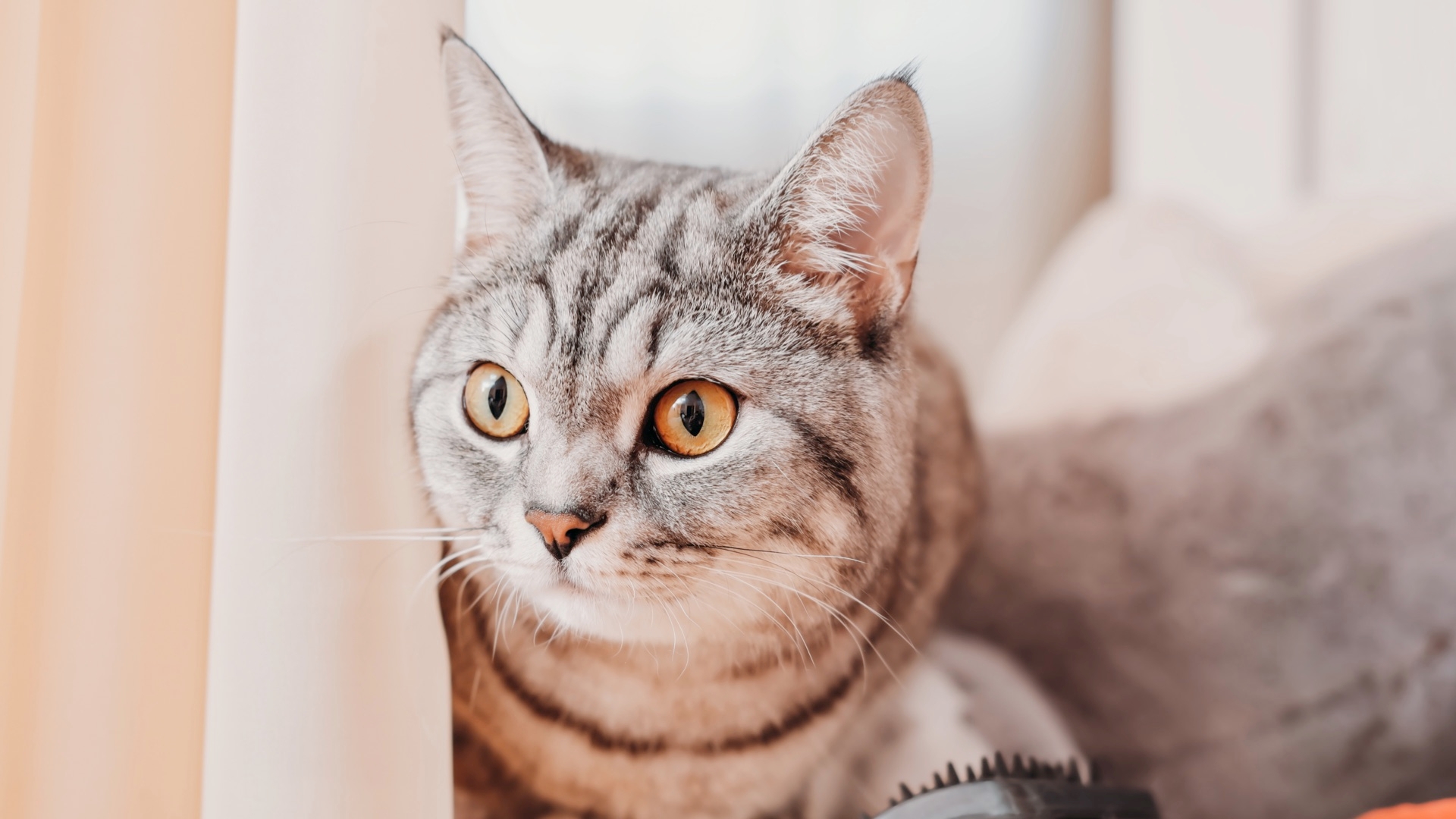The World According To Your Cat:
Summary:
Your cat hears, sees, smells, tastes, and feels the world differently than you do (and processes it all through a very different brain), so it should be no surprise that there are often miscommunications between humans and cats! To understand and to ultimately change your cat's behavior, it is essential that you understand how your cat interprets the world.
Your cat hears, sees, smells, tastes, and feels the world differently than you do (and processes it all through a very different brain), so it should be no surprise that there are often miscommunications between humans and cats! To understand and to ultimately change your cat's behavior, it is essential that you understand how your cat interprets the world.
Hearing
Although not as good at detecting lower pitches, cats can pick up sounds so faint or high-pitched they are out of the range of human hearing. Sound is an important part of the cat's world for both surviving and communicating. Listen to how many different sounds your cat makes—this is your cat communicating in an undeniably complex language. Because your cat hears high-pitched sounds better than you, it is important that you be aware of noise levels in your home, particularly if your cat is timid or easily upset by commotion. Are you playing music loudly or using the vacuum cleaner? If your cat is reacting to these sounds, it is best to create a quiet, calm room for your cat to stay in while you are cleaning or entertaining guests.
Smell
The wet, pebbly patch of skin on your cat's nose is called a rhinarium. It can catch and hold scent molecules, and it gives your cat a superior sense of smell. In fact, smell is so important to a cat's survival that they have a secondary olfactory organ. On the roof of a cat's mouth behind the front teeth is the vomeronasal organ, which you can see when your cat yawns. When confronted with an especially interesting or unusual smell, a cat will drop its jaw open and let the scent waft across the vomeronasal organ in a behavior called the Flehmen response.
In addition, because scent is vital to cats, they will mark just about anything. For cats, scent is a means of communication. Try this experiment yourself: present your cat with a new object and observe his reaction. Most likely, your cat will smell the object. If it looks interesting (and inedible and nonthreatening), the cat will butt the object with his head and rub the side of his face (and sometimes his whole body) against the object. Your cat has just claimed the new object by marking it with pheromones. Cats have scent glands on the sides of their faces and in other places along their bodies and tails. In the wild, scenting is the way cats communicate with other cats. When your cat weaves around your legs or ankles, he is showing love by depositing his unique scent and claiming you as his own!
Scenting and marking territory with urine is another way cats communicate "owned" property. For cats who are domesticated and reside in a house, spraying urine can create considerable problems within the household. For more information on understanding spraying and modifying the behavior, turn to the Litter Box 101 article.
Scratching
Scratching is an instinctive behavior that has many practical purposes, such as scenting, stretching and exercising, and keeping nails in good condition. Cats scratch for multiple reasons, and although this behavior is useful and necessary for both the mental and physical health of your cat, the behavior often can be at odds with a guardian's desire to keep furniture intact and pristine. Luckily, there are many ways to keep cats from scratching inappropriate surfaces. Read more about the importance of scratching and painless, easy alternatives to declawing in the article Why Cats Need Their Claws on our website.
Touch
Cats have a very keen and sophisticated sense of touch; they have millions of touch receptors all over their bodies. These receptors are most numerous in the face (nose, whiskers) and feet (paw/paw pad) areas. The whiskers of a cat are extremely sensitive to touch and are important in helping the cat to feel for prey while he is hunting or navigating around dark areas and through narrow passages (the whiskers will tell the cat if he can fit into a small passage way or between two objects). The touch receptors in the paw pads are also adapted for hunting and are valuable in helping a cat to determine the type of prey (even in the dark) and if the prey is still alive. Paw pads and nose touch receptors are also very sensitive to temperature.
Taste
Since taste is related to smell, and cats have a superior sense of smell, their sense of taste is exceptional, too. However, this does not necessarily mean your cat has what we might consider good taste. Cats will put things in their mouths that we find disgusting or unclean. This is part curiosity and part necessity, as the only way for cats to carry something is in their mouths.
When it comes to food, cats have different likes and dislikes. It is important for you to discover what type of food is appealing to your cat to ensure he eats well. It is also important, however, for you to be aware of what diet is healthiest for your cat. Sometimes the food your cat wants to eat is not always the healthiest option—just like children, cats often prefer "junk food" to healthy, nutritionally complete foods. For more information on this topic, please read the article Feline Diet and Nutrition found on our website.
Vision
Contrary to popular belief, cats cannot see in total darkness. Mammals need some light to see; however, cats are very well equipped to see in minimal light. Unlike our pupils, which expand and contract as a circle, cats' pupils begin as tiny vertical slits that can open to include the entire iris, the colored portion of the eye. The tapetum is a reflective layer of cells at the back of the eye that bounces even the faintest light back through the light-sensitive cells. Have you ever noticed your cat's eyes glowing at night? The glowing is actually light reflected off the tapetum. This reflective feature enhances a cat's ability to best utilize low amounts of light, a trait all nocturnal animals need to survive.
Nocturnal instincts
Cats are naturally nocturnal (most active at night) and crepuscular (most active at dawn and dusk) animals. If we consider that the domesticated cat's ancestors came from the plains and deserts of Africa, the modern cat's midnight antics make perfect sense. Temperatures rise dramatically during the day on the African grasslands. To survive the heat, animals find shade and sit still. A smart predator (which the cat most certainly is) won't waste energy searching out hiding places of prey and chasing down game while the sun is up. At sunset, the temperature drops and darkness hides movement. This is the ideal time to come out to find food and water, and it is precisely the time when the ancestors of your cat went on the prowl. So your cat's noisy charging around at 3:00 a.m. isn't necessarily a "behavior problem"—it's an instinct! For more information on how to combat nocturnal "behavior problems," read Changing Your Cat's Behavior.
Climbing and leaping
Any horizontal surface is an invitation to a cat. A young and determined cat can leap almost straight up two or three times his body length. In human terms, that would mean being able to highjump about 12-to-18 feet from a dead start. Cats also will fearlessly jump several feet across horizontal chasms and "tight-rope" walk along narrow passages many feet off the ground. Cats also like to "roost" in high places—atop the refrigerator or on the top shelf of the closet. This desire to climb and sleep in high places is a survival instinct passed on from their wild ancestors. In the wild, cats have to follow prey up cliff faces and along the limbs of trees. In addition, cats in the wild have to hide from predators, and the best place to hide is up high where nothing can sneak up behind them. These survival instincts are alive and well in even the laziest domesticated house cat!
Aversion to drinking water
Many domesticated cats live day-today being slightly dehydrated. This is due, in part, to their desert ancestry, when they were engineered to survive without access to regular water sources. Domesticated cats sometimes require encouragement to drink. Try including moisture-rich wet food in your cat's diet. It is also important to have more than one water bowl and to place these bowls throughout the house. Sometimes cats are more inclined to drink from water bowls that are in a different location than their food bowls. You can also invest in water fountains, as many cats prefer to drink from running-water sources. Also, be sure to place your cat's water bowls in safe, quiet areas away from dogs, young children, or general household commotion. Remember, in the wild, cats take time to drink only when it's quiet and they're safe from predators.


